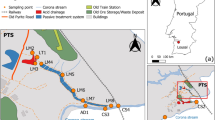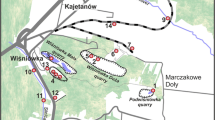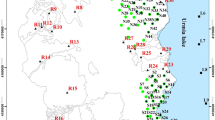Abstract
The commonly observed enrichment of middle rare earth elements (MREE) in water sampled in acid mine drainage (AMD)-impacted areas was found to be the result of preferential release from the widespread mineral pyrite (FeS2). Three different mining-impacted sites in Europe were sampled for water, and various pyrite samples were used in batch experiments with diluted sulphuric acid simulating AMD-impacted water with high sulphate concentration and high acidity. All water samples independent on their origin from groundwater, creek water or lake water as well as on the surrounding rock types showed MREE enrichment. Also the pyrite samples showed MREE enrichment in the respective acidic leachate but not always in their total contents indicating a process-controlled release. It is discussed that most probably complexation to sulphite (SO3 2−) or another intermediate S-species during pyrite oxidation is the reason for the MREE enrichment in the normalized REE patterns.



Similar content being viewed by others
References
Assarsson G, Grundulis V (1961) Chemical investigations of upper Cambrian shales at Hynneberg, Närke. Geol Fören Förhandl 83:269–277
Bau M, Dulski P (1996) Distribution of yttrium and rare-earth elements in the Penge and Kuruman iron-formations, Transvaal Supergroup South Africa. Precambrian Res 79:37–55
Bau M, Möller P (1992) Rare earth element fractionation in metamorphogenic hydrothermal calcite, magnesite and siderite. Mineral Petrol 45:231–246
Bozau E, Leblanc M, Seidel JL, Stärk HJ (2004) Light rare earth elements enrichment in an acidic mine lake (Lusatia, Germany). Appl Geochem 19:261–271
Cook NJ, Ciobanu CL (2004) Bismuth tellurides and sulphosalts from the Larga hydrothermal system, Metaliferi Mts, Romania: paragenesis and genetic significance. Mineral Mag 68:301–321
Cook NJ, Ciobanu CL, Pring A, Skinner W, Shimizu M, Danyushevsky L, Saini-Eidukat B (2009) Trace and minor elements in sphalerite: a LA-ICP-MS study. Geochim Cosmochim Acta 73:4761–4791
Cruz R, Bertrand V, Monroy M, González I (2001) Effect of sulfide impurities on the reactivity of pyrite and pyritic concentrates: a multi-tool approach. Appl Geochem 16:803–819
Deditius AP, Utsunomiya S, Reich M, Kesler SE, Ewing RC, Hough R, Walshe J (2011) Trace metal nanoparticles in pyrite. Ore Geol Rev 42:32–46
Descostes M, Vitorge P, Beaucaire C (2004) Pyrite dissolution in acidic media. Geochim Cosmochim Acta 68:4559–4569
Duma S (2009) The impact of mining activity upon the aquatic environment in the southern Apuseni Mountains. Rom Rev Reg Stud 5:51–66
Einax JW, Zwanziger HW, Geiß S (1997) Chemometrics in environmental analysis. Wiley-VCH, Weinheim
Elderfield H, Upstill-Goddard R, Sholkovitz ER (1990) The rare earth elements in rivers, estuaries, and coastal seas and their significance to the composition of the ocean waters. Geochim Cosmochim Acta 54:971–991
García MG, Lecomte KL, Pasquini AI, Formica SM, Depetris PJ (2007) Sources of dissolved REE in mountainous streams draining granitic rocks, Sierras Pameanas (Córdoba, Argentina). Geochim Cosmochim Acta 71:5355–5368
Gimeno Serrano MJ, Sanz LFA, Nordstrom DK (2000) REE speciation in low-temperature acidic waters and the competitive effects of aluminum. Chem Geol 165:167–180
Grandjean-Lécuyer P, Feist R, Albarede F (1993) Rare-earth elements in old biogenic apatites. Geochim Cosmochim Acta 57:2507–2514
Grawunder A, Lonschinski M, Merten D, Büchel G (2009) Distribution and bonding of residual contamination in glacial sediments at the former uranium mining leaching heap of Gessen/Thuringia, Germany. Chem Erde 69(S2):5–19
Grawunder A (2010) Hydrogeochemistry of rare earth elements in an acid mine drainage influenced area. Dissertation, Friedrich Schiller University, Jena
Grawunder A, Lonschinski M, Boisselet T, Merten D, Büchel G (2010) Hydrogeochemistry of rare earth elements in an AMD-influenced area. – In: Wolkersdorfer Ch, Freund A (Eds): Mine Water & Innovative Thinking. Sydney, Nova Scotia (CBU Press), p. 347 – 351
Grawunder A, Merten D (2012) Rare earth elements in acidic systems—biotic and abiotic impacts. In: Kothe E, Varma A (Eds) Bio-geo interactions in metal-contaminated soils. Soil Biology Vol. 31, Springer, Berlin, p. 81–97
Haley BA, Klinkhammer GP, McManus J (2004) Rare earth elements in pore waters of marine sediments. Geochim Cosmochim Acta 68:1265–1279
Hannigan RE, Sholkovitz ER (2001) The development of middle rare earth element enrichments in freshwaters: weathering of phosphate minerals. Chem Geol 175:495–508
Ichikuni M (1960) Sur la dissolution des minerais sulfurés en divers milieu. II. Dissolution de la pyrite et de la chalcopyrite. Bull Chem Soc Jpn 33:1052–1057 (in French)
Johannesson KH, Lyons WB, Yelken MA, Gaudette HE, Stetzenbach KJ (1996) Geochemistry of the rare-earth elements in hypersaline and dilute acidic natural terrestrial waters: complexation behavior and middle rare-earth element enrichments. Chem Geol 133:125–144
Johannesson KH, Lyons WB (1995) Rare-earth element geochemistry of Color Lake, an acidic freshwater lake on Axel-Heiberg-Island, Northwest-Territories, Canada. Chem Geol 119:209–223
Johannesson KH, Zhou XP (1997) Geochemistry of the rare earth elements in natural terrestrial waters: a review of what is currently known. Chin J Geochem 16:20–42
Johannesson KH, Zhou XP (1999) Origin of middle rare earth element enrichments in acid waters of a Canadian High Arctic lake. Geochim Cosmochim Acta 63:153–165
Jones A, Rogerson M, Greenway G, Potter HAB, Mayes WM (2013) Mine water geochemistry and metal flux in a major historic Pb-Zn-F orefield, the Yorkshire Pennines, UK. Environ Sci Pollut Res 20:7570–7581
Jørgensen BB, Bak F (1991) Pathways and microbiology of thiosulfate transformations and sulfate reduction in a marine sediment (Kattegat, Denmark). Appl Environm Microbiol 57:847–856
Karlsson S, Sjöberg V, Pourjabbar, A, Grandin A and Allard B (2012) Distribution of rare earth elements and other metals in a stratified acidic pit lake in black shales 45 years after mine closure. In: Price WA, Hogan C, Tremblay G (Eds) Proceedings 9th International Conference on Acid Rock Drainage (ICARD) 2012; Ottawa, Canada (CD-ROM, 12p)
Lange G, Mühlstedt P, Freyhoff G, Schröder B (1991) Der Uranerzbergbau in Thüringen und Sachsen—ein geologisch bergmännischer Überblick. Erzmetall 44:162–171 (in German)
Lécuyer C, Reynard B, Grandjean P (2004) Rare earth element evolution of Phanerozoic seawater recorded in biogenic apatites. Chem Geol 204:63–102
Lehner S, Savage K (2008) The effect of As, Co, and Ni impurities on pyrite oxidation kinetics: batch and flow-through reactor experiments with synthetic pyrite. Geochim Cosmochim Acta 72:1788–1800
Luther GW (1987) Pyrite oxidation and reduction: molecular orbital theory considerations. Geochim Cosmochim Acta 51:3196–3199
Mao G, Hua R, Gao J, Li W, Zhao K, Long G, Lu H (2009) Existing forms of REE in gold-bearing pyrite of the Jinshan gold deposit, Jiangxi Province, China. J Rare Earths 27:1079–1087
McLennan SM (1989) Rare earth elements in sedimentary rocks: influence of provenance and sedimentary processes. In: Lipin BR, McKay GA (Eds) Geochemistry and mineralogy of rare earth elements. Rev Min Geochem 21:169–200
McLennan SM (1994) Rare earth element geochemistry and the “tetrad” effect. Geochim Cosmochim Acta 58:2025–2033
Medas D, Cidu R, Lattanzi P, Podda F, De Giudici G (2012) Natural biomineralization in the contaminated sediment–water system at the Ingurtosu abandoned mine. In: Kothe E, Varma A (eds) Bio-Geo interactions in metal-contaminated soils. Soil Biology Vol. 31, Springer, Berlin, pp 113–130
Merten D, Geletneky J, Bergmann H, Haferburg G, Kothe E, Büchel G (2005) Rare earth element patterns: a tool for understanding processes in remediation of acid mine drainage. Chem Erde 65(S1):97–114
Morgan JW, Wandless GA (1980) Rare earth element distribution in some hydrothermal minerals: evidence for crystallographic control. Geochim Cosmochim Acta 44:973–980
Moses CO, Nordstrom DK, Herman JS, Mills AL (1987) Aqueous pyrite oxidation by dissolved oxygen and by ferric iron. Geochim Cosmochim Acta 51:1561–1571
Nagasawa H (1971) Partitioning of Eu and Sr between coexisting plagioclase and K-feldspar. Earth Planet Sci Lett 13:139–144
Neubauer F, Lips A, Kouzmanov K, Lexa J, Ivǎşcanu P (2005) 1: Subduction, slab detachment and mineralization: the Neogene in the Apuseni Mountains and Carpathians. Ore Geol Rev 25:13–44
Pérez-López R, Gelgado J, Nieto JM, Márquez-García B (2010) Rare earth element geochemistry of sulphide weathering in the São Domingos mine area (Iberian Pyrite Belt): a proxy for fluid–rock interaction and ancient mining pollution. Chem Geol 276:29–40
Reynard B, Lécuyer C, Grandjean P (1999) Crystal-chemical controls on rare-earth element concentrations in fossil biogenic apatites and implications for paleoenvironmental reconstructions. Chem Geol 155:233–241
Smedley PL (1991) The geochemistry of rare-earth elements in groundwater from the Carnmenellis Area, Southwest England. Geochim Cosmochim Acta 55:2767–2779
Sverjensky DA (1984) Europium redox equilibria in aqueous solution. Earth Planet Sci Lett 67:70–78
Verplanck PL, Nordstrom DK, Taylor HE, Kimball BA (2004) Rare earth element partitioning between hydrous ferric oxides and acid mine water during iron oxidation. App Geochem 19:1339–1354
Welch SA, Christy AG, Isaacson L, Kirste D (2009) Mineralogical control of rare earth elements in acidic sulfate soils. Geochim Cosmochim Acta 73:44–64
Wismut GmbH (1994) Sanierungskonzept Standort Ronneburg. Stand Dezember 1994. Internal Report, Wismut GmbH, Chemnitz (in German)
Xu Y, Schoonen MAA (1995) The stability of thiosulfate in the presence of pyrite in low-temperature aqueous solutions. Geochim Cosmochim Acta 59:4605–4622
Zhao KD, Jiang SY (2007) Rare earth element and yttrium analyses of sulfides from the Dachang Sn-polymetallic ore field, Guangxi Province, China: implication for the ore genesis. Geochem J 41:121–134
Acknowledgements
The authors thank the project “Umbrella” funded by the EU (FP7-ENV-2008-1 no. 226870) under the coordination of E. Kothe (Friedrich Schiller University Jena) for financial support. Further, we thank I. Kamp, G. Rudolph and G. Weinzierl (all Friedrich Schiller University Jena) for ICP-OES, DOC and IC measurements, as well as all partners within the Umbrella project, especially the Swedish group (B. Allard, M. Bäckström, S. Karlsson, V. Sjöberg; University of Örebro) and the Romanian group (A. Neagoe, V. Iordache; University of Bucharest) for enabling access to the field sites and supporting us during field work, and G. De Giudici (University of Cagliari) for helpful comments. We also thank an anonymous reviewer for helpful comments improving the manuscript once more. Furthermore, we are grateful to A. Kötschau (Friedrich Schiller University Jena) for support on statistical analysis, as well as B. Kreher-Hartmann from the Mineralogical Collection of the Friedrich Schiller University Jena, S. Meißner and M. Riefenstahl for providing further mineral samples and F. Schäffner (Friedrich Schiller University Jena) as well as P. T. Stancu (University of Bucharest) for their help during field work.
Author information
Authors and Affiliations
Corresponding author
Additional information
Responsible editor: Philippe Garrigues
Rights and permissions
About this article
Cite this article
Grawunder, A., Merten, D. & Büchel, G. Origin of middle rare earth element enrichment in acid mine drainage-impacted areas. Environ Sci Pollut Res 21, 6812–6823 (2014). https://doi.org/10.1007/s11356-013-2107-x
Received:
Accepted:
Published:
Issue Date:
DOI: https://doi.org/10.1007/s11356-013-2107-x




